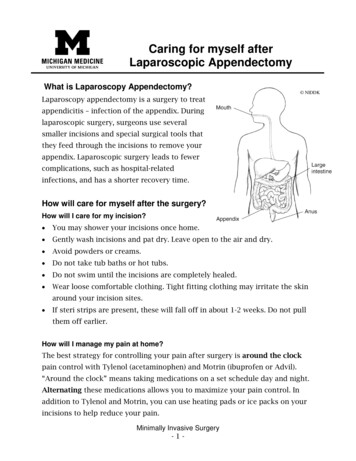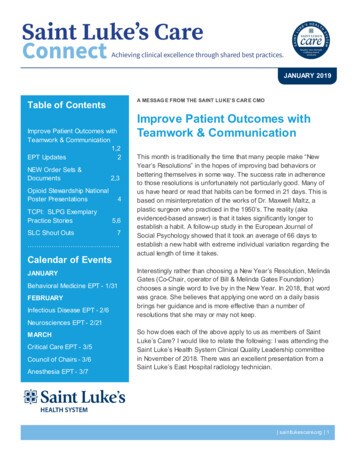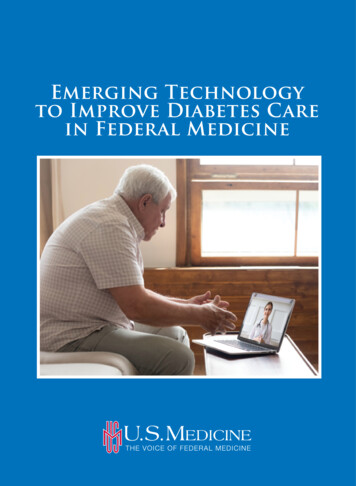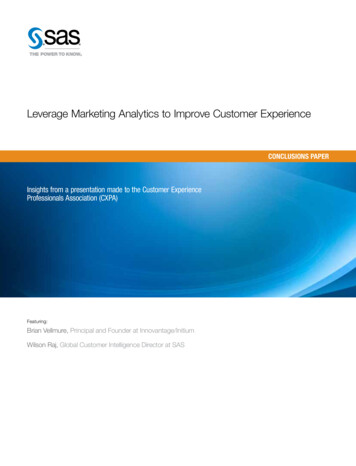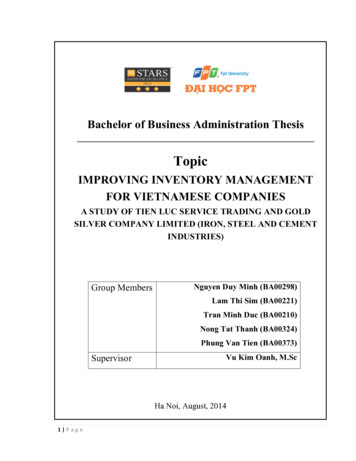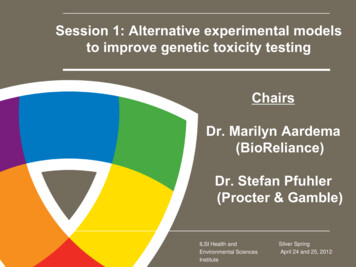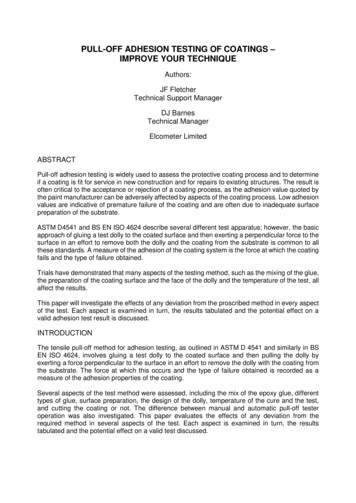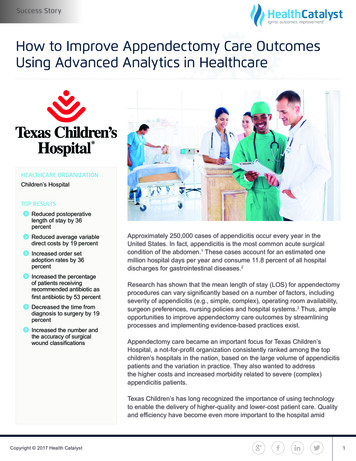
Transcription
Success StoryHow to Improve Appendectomy Care OutcomesUsing Advanced Analytics in HealthcareHEALTHCARE ORGANIZATIONChildren’s HospitalTOP RESULTSReduced postoperativelength of stay by 36percentReduced average variabledirect costs by 19 percentIncreased order setadoption rates by 36percentIncreased the percentageof patients receivingrecommended antibiotic asfirst antibiotic by 53 percentDecreased the time fromdiagnosis to surgery by 19percentIncreased the number andthe accuracy of surgicalwound classificationsApproximately 250,000 cases of appendicitis occur every year in theUnited States. In fact, appendicitis is the most common acute surgicalcondition of the abdomen.1 These cases account for an estimated onemillion hospital days per year and consume 11.8 percent of all hospitaldischarges for gastrointestinal diseases.2Research has shown that the mean length of stay (LOS) for appendectomyprocedures can vary significantly based on a number of factors, includingseverity of appendicitis (e.g., simple, complex), operating room availability,surgeon preferences, nursing policies and hospital systems.3 Thus, ampleopportunities to improve appendectomy care outcomes by streamliningprocesses and implementing evidence-based practices exist.Appendectomy care became an important focus for Texas Children’sHospital, a not-for-profit organization consistently ranked among the topchildren’s hospitals in the nation, based on the large volume of appendicitispatients and the variation in practice. They also wanted to addressthe higher costs and increased morbidity related to severe (complex)appendicitis patients.Texas Children’s has long recognized the importance of using technologyto enable the delivery of higher-quality and lower-cost patient care. Qualityand efficiency have become even more important to the hospital amidCopyright 2017 Health Catalyst1
PRODUCTSLate-BindingTM DataWarehousePopulation AnalyticsAdvanced ApplicationAppendectomy Modulethe impending transformation of the reimbursement system from fee-forservice to value-based payments. The hospital system is moving fromcost-based reimbursement for Medicaid to a form of value-based paymentunder which hospitals that improve efficiency can keep the savings.This case study details how Texas Children’s is using analytics technology,team-based processes and evidence-based best practices to drive higherquality, lower-cost care for appendicitis.SERVICESInstallation ServicesTHE PROBLEM: LACK OF DATA, LACK OF BUY-INClinical ImprovementServicesConsistent with nationwide trends, Texas Children’s found thatappendectomies represented one of their largest categories of surgicalcases — with more than 1,000 appendectomy procedures each year.Based on the incomplete data they had gathered, they also discoveredtremendous variability in LOS, costs and outcomes.To improve costs and outcomes, the quality improvement team workedwith the hospital’s Evidence Based Outcomes Center (EBOC), whichdevelops evidence-based clinical guidelines to help clinicians manage thecomplexity of care and minimize variations in clinical practice. The teamidentified evidence-based practice guidelines and rolled them out amongclinicians; however, there was no system in place to monitor outcomesafter implementation of the guideline, or to track clinician adherence tothe guidelines over time.Another challenge Texas Children’s faced in improving appendectomy carewas a lack of data. What data they had was delayed and retrospectiveand wasn’t gathered in a uniform, systematic way. The typical methodfor gathering the necessary data was for research residents and fellowsto pull data from charts and analyze results. This effort was important interms of generating answers to research hypotheses, but was not flexibleor efficient in providing near-real time outcomes data necessary for guidingpatient care. Additionally, it consumed resources and required retraining asresidents completed their research rotations.APPLYING THE THREE SYSTEMS APPROACH TO APPENDECTOMYPROCEDURESTexas Children’s turned to a technology-driven approach to enable itsclinicians to deliver higher-quality and lower-cost appendectomy care. Thehospital had already worked with Health Catalyst to implement a clinical,analytic and process-based framework for value-based transformation.This framework, known as the Three Systems Approach:Copyright 2017 Health Catalyst2
Improves measurement and analytics (an analytics system)Creates permanent cross-functional workgroup teams focused onidentifying, deploying and monitoring the effectiveness of qualityimprovements (a deployment system)Deploys a data-driven approach to implementing evidence-basedbest practices (a content system)The hospital was using this framework to improve other clinical andoperational processes, such as asthma care. They determined to applythese three systems to appendectomy care.Before implementingHealth Catalyst’sEDW solution, wehad no commonplatform for assessingour appendectomyperformance. Thequality departmentmight have oneopinion aboutperformance levels,and surgeons mighthave differentinformation andanother opinion.There was no datafor everyone toagree on and useas a foundation forunderstanding ourperformance. Andyou can’t improve onsomething you don’tunderstand!Kathleen E. Carberry, RN, MPHDirector of Hospital Outcomesand Impact Service, TexasChildren’s HospitalCopyright 2017 Health CatalystSpecifically, the program incorporated the following elements:The Health Catalyst Enterprise Data Warehouse (EDW) platform,designed to handle the massive quantities of data in largehealthcare organizations. The EDW organizes the hospital’s datainto a single source of truth that serves as a foundation for datadriven improvement. The data warehouse enabled Texas Children’sto eliminate the manual data gathering process and automate datadistribution. Analysts could then devote their time to discoveringpatterns in the data that could be used to understand wherechanges needed to be made.Population Analytics Advanced Application – Appendectomy Module,which enables teams to actively measure the effectiveness andoutcomes of care improvement interventions for the specific patientpopulation. Using an Agile development process that involvedan integrated workgroup of clinicians and technical personnel,Texas Children’s was able to quickly define and refine its patientpopulations — and achieve buy-in from clinicians of the analyticsplatform as a single source of truth.Permanent, integrated workgroup teams that identify areas for careimprovement and build evidence-based practices into the caredelivery workflow. The workgroup consisted of clinicians (surgeons),a research nurse, and a data specialist and data architect. Theworkgroup also had ad-hoc representation as needed from othergroups, such as ED clinicians and finance personnel. The teamworked with clinicians and staff on the frontlines of care to evaluateand develop clinician training, nursing plans and patient educationmaterials, ensuring effective system-wide implementation of bestpractices. The team received support from Texas Children’s qualitydepartment including the senior vice president of quality, chief qualityofficers for surgery and medicine, and the chief of clinical systemsintegration. They also received support from the chief informationofficer and senior vice president for information services. Thepartnership between quality and information systems, at the highestlevels of the organization, was critical to the successful execution ofthis new data-driven care delivery paradigm.3
Evidence-based best practices, which guided the workgroup as itidentified areas where care could be improved and standardized.To determine the points in the appendectomy care process whereevidence-based best practices could be applied to standardize andimprove care, the team mapped out the appendectomy procedureworkflow, from diagnosis to after care. The team consulted withthe EBOC to discover the latest evidence-based recommendedpractices. One such practice that the team incorporated into theworkflow was the use of the antibiotic Piperacillin to help reducesurgical site infections by tailoring treatment to address the localmicrobiology of complex appendicitis.Surgeons are trainedto measure, but asophisticated levelof analytics andmeasurement has, upto now, always lived inan academic setting.What we are doingis operationalizingthis kind of analyticsin a hospital setting.We are determininghow to measureperformance in a waythat is reliable andongoing. We don’twant to tackle thiskind of work on an adhoc, project by projectbasis. Instead, we’reputting a strategicsystem in placethat will allow us tocontinually improve.Monica E. Lopez, MDAttending Surgeon,Pediatric Surgery Service ,Texas Children’s Hospital,Assistant Professor ofSurgery and Pediatrics,Baylor College of MedicineBecause the permanent workgroup owns improvement for one particularcare family over the long-term and is able to work with the EDW datain near real time via easy-to-use dashboards, they are successfullystandardizing excellence in their care delivery work processes.RESULTS: PERFORMANCE IMPROVEMENT USING ANALYTICS INHEALTHCAREAlthough clinical transformation is an ongoing, iterative process, TexasChildren’s appendectomy team has had impressive, measurable successin a short amount of time.Developed appendectomy population health analytics platformUsing the EDW and the Appendectomy Module, Texas Children’s hasdeveloped a robust population health analytics platform for appendectomycare. Data from multiple source systems is now quickly integrated toenable prospective analytics in healthcare. This means that the teamcan assess outcomes for the population over an extended period oftime and relate those outcomes to factors such as treatment protocolsand suspected risk. Because clinicians were involved in developing theplatform, they trust the data and use it as their single source of truth aboutappendectomy outcomes.Visualizations available in the Appendectomy Module allow for easyidentification of improvement opportunities and quick recognition of dataquality issues. It is easy for individual clinicians and analysts to delveinto the data themselves without having to request a report from the ITdepartment. These clinicians and analysts are now able to compare dataacross all Texas Children’s locations where appendectomies are performedand stratify data based on patient characteristics such as age, gender, typeof disease, etc. Prior to the EDW and Appendectomy Module, the teamwould spend several months just trying to collect the data.Improved patient outcomes and reduced costs through culturaltransformationIn the Three Systems Approach that Health Catalyst advocates and TexasChildren’s adopted, all systems — analytics, deployment and content —Copyright 2017 Health Catalyst4
work together to establish an organization whose culture is one of datadriven improvement. The following results stem from the interaction of thesethree systems. Implementation of these systems results in a unique culturewhere clinicians on the frontlines of care use data and technology to make adifference in patients’ lives.1. Cultural transformationCombining a single, agreed-upon source of truth with clinician engagementenables the Texas Children’s team to use data in an ongoing cycle ofcontinuous improvement. This effort has required concerted efforts toeducate clinicians. Here is just one example of how engaging clinicianswith data is driving cultural transformation. Surgeons are trained todocument the severity of the case in the operative note. The teamleverages an appendectomy visualization (sample shown in Figure 1)to estimate the number of severity changes that are made, which helpsidentify potential gaps in documentation.Sample appendectomycoding visualization1. Tabular and graphicaldisplays of appendectomytype coding changes madequarterly by billing2. Filters enable comparisonacross campuses3. Drill-downcapabilities for surgeon andpatient-level details13213Figure 1: Sample appendectomy coding visualizationAs part of education and process improvement, the team trained thephysicians on the operative note template. They share the metrics withphysicians to establish an ongoing culture of transformation using data.Cultural transformation efforts have also involved nurse and family education.Nursing education and engagement: The team worked with nurseson a wound classification initiative that was designed to helpeducate nurses on how to accurately code wound class for simpleand complex appendicitis. Surgical wound class is an importantand useful quality measure for risk stratification. This information isCopyright 2017 Health Catalyst5
Establishing a singlesource of truththrough the EDW hasgiven us a sharedunderstanding ofappendicitis outcomesacross the enterprise.Seeing what ispossible with datais driving significantcultural transformationin our organization— and moving usinto a new era ofmeasurement.reportable to the public and third party payers, and may be linked toreimbursement for treatment of surgical site infections. The impact oftraining on surgical wound classifications is illustrated in Figure 2 andhas resulted in the following positive year over year outcomes4:Increased the wound class coding by nine percentIncreased the accuracy of the coding as demonstrated by thefact that “clean” wound classifications decreased by five percent,while “contaminated” and “dirty or infected” classificationsincreased by 30 and 29 percent, respectively.Kathleen E. Carberry, RN, MPHDirector of Hospital Outcomesand Impact Service, TexasChildren’s HospitalFigure 2: Sample appendectomy wound classificationFamilies and patients: The team developed an education pamphlet— for simple appendicitis — to help set expectations for parents ordesignated caregivers of patients at the beginning of the process.This education continues throughout the care pro
surgeon preferences, nursing policies and hospital systems. 3. Thus, ample opportunities to improve appendectomy care outcomes by streamlining processes and implementing evidence-based practices exist. Appendectomy care became an important focus for Texas Children’s Hospital, a not-for-profit organization consistently ranked among the top
